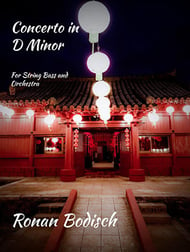
Concerto No. 2 in D Minor
Publisher Desc.
This piece, a sister to the first Concerto in E Major, is an exciting and
energetic piece written for an advanced String Bass player.
(Movement 1 - Tempo di Marcia): This movement is written in a march style,
and a theme and variations form. The opening theme is introduced by the
Horns, and then expanded on by the soloist at letter A. The woodwinds and
first violins bring in a variation on the first theme at Letter C in the
orchestral tutti. The trio is a tango style fantasy on the opening theme,
with a key change from D Minor to G Minor. The "dog fight" at
letter F gives the soloist a chance to let out all of their pent-up anger and
go ham. Letter G brings back the opening theme, this time played in G minor,
and adds a call-and-response element to the theme, with a response given by
the woodwinds.
(Movement 2 - Silent Night: Reimagined) The first concerto by the composer
had a fantasized version of the Christmas carol "In the Bleak
Midwinter." This concerto has a dramatic reimagination of "Silent
Night." The strings in the opening of this movement give us a smooth
transition from minor mode to major, with a harp solo going in the
background. Leading into H, the strings modulate to D Major, where a twisted
version of "Silent Night" is performed by the soloist. At J, the
woodwinds perform the main theme of the carol, with tremolo strings giving a
wintery texture in the background. Going into K, we go back into minor mode,
as the soloist introduces a new flowing theme, going into another cadenza.
Letter L restates "Silent Night" with the soloist performing some
variations on the theme using harmonics in the upper range of the bass.
Letter M gets really quiet, and quotes a theme from the first concerto by the
composer, as well as another piece, "Elegie in D Minor," written
for String Orchestra. It builds into N, where the whole orchestra comes in
and "sings" the composer's signature theme, which is used in all of
his original pieces. As we calm down at the end, multiple instruments play
the last notes of the first stanza, "Sleep in heavenly peace."
Watch out for the jumpscare chord at the end of this movement.
(Movement 3 - Feroce-Presto!) Here's the final stretch! The whole orchestra
gives a powerful opening, which is immediately hushed by the strings, which
provides a steady, but urgent ostinato, which helps keep to soloist moving in
this smooth, but dire melody, which builds into a big and bold unison played
by the upper strings and horns, plus the soloist at letter Q. Then at Q.5, we
build into an orchestral tutti at letter R, where the upper woodwinds and all
of the strings scream a continuous rhythm, while the brass shout out unison
notes within the C# diminished chord, as the notes within the ostinato dement
more and more going into the cadenza. The provided cadenza is highly
recommended, as it includes quotes from the second movement, as well as the
first concerto by the composer. At letter S, the time goes to a fast 4/4,
where the composer's signature theme is played once more, layered with a new
theme presented by the bass voices in the orchestra. The ending of this
concerto is similar to the ending of the first one to solidify the
relationship between the two sister pieces.
Select a Product
My Library













































































